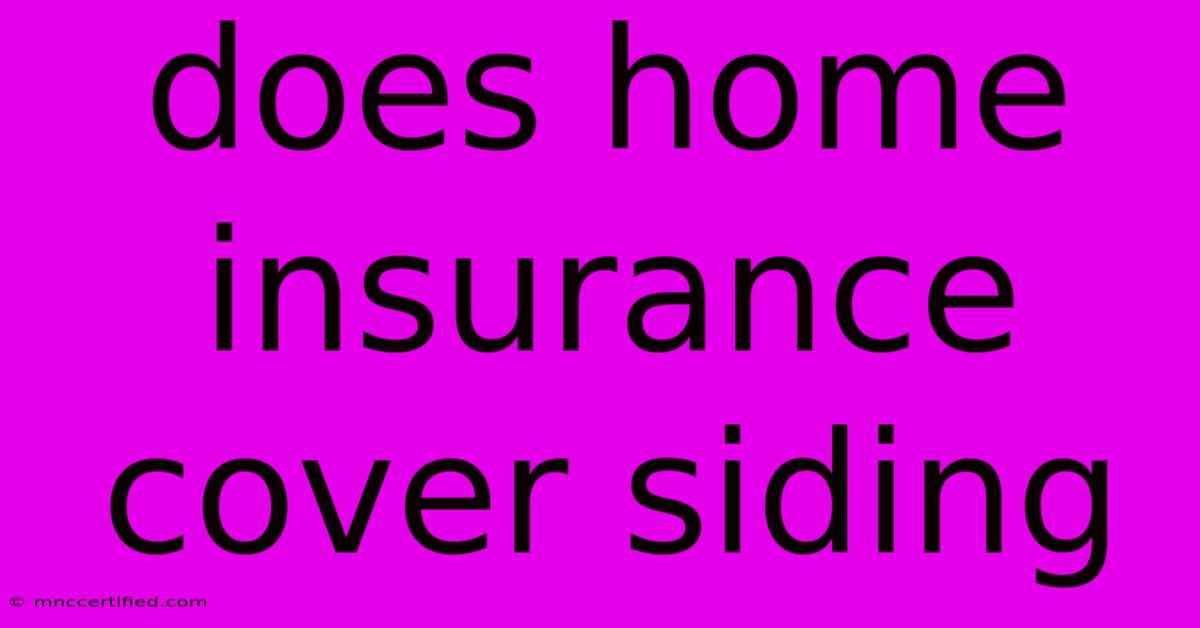Does Home Insurance Cover Siding

Table of Contents
Does Home Insurance Cover Siding Damage? A Comprehensive Guide
Homeowners often wonder about the extent of their insurance coverage, especially when unexpected damage occurs. One common concern revolves around siding: does home insurance cover siding repair or replacement? The answer, unfortunately, isn't a simple yes or no. It depends on several factors, including the cause of the damage and the specifics of your policy. This comprehensive guide will help you understand what to expect.
Understanding Your Home Insurance Policy
Before diving into siding coverage, it's crucial to thoroughly understand your homeowner's insurance policy. Your policy document, available either physically or digitally, outlines what's covered and what's excluded. Key sections to focus on include:
- Perils Covered: This section lists the events your insurance covers, such as fire, windstorms, hail, vandalism, and lightning. Damage caused by these covered perils usually includes siding repair or replacement.
- Exclusions: This equally important section specifies events not covered by your policy. Common exclusions might include damage from normal wear and tear, insect infestation, or improper maintenance.
- Deductible: Remember your deductible – the amount you pay out-of-pocket before your insurance coverage kicks in. This applies to siding repairs or replacements as well.
Common Causes of Siding Damage and Insurance Coverage
Let's examine some typical scenarios and whether your home insurance is likely to cover siding repairs or replacement:
Covered Causes:
- Windstorms and Hail: Damage from high winds, flying debris, or hail is often covered under standard homeowner's insurance policies. Photos documenting the damage are crucial for successful claims.
- Fire and Lightning: If a fire or lightning strike damages your siding, insurance will typically cover the repairs or replacement.
- Vandalism and Malicious Mischief: Damage intentionally caused by others is usually covered, assuming you have the appropriate coverage.
- Falling Objects: Damage from falling trees or other objects is often covered, provided the event was unforeseen and not due to negligence.
Potentially Uncovered Causes:
- Normal Wear and Tear: Fading, cracking, or minor damage due to age and exposure to the elements is generally not covered.
- Pest Infestation: Damage caused by termites, carpenter ants, or other pests is typically not covered unless you have a specific pest infestation endorsement.
- Neglect or Poor Maintenance: If the damage stems from a lack of maintenance, such as failing to address a leak, your claim might be denied.
- Acts of God (Certain Circumstances): While some acts of God are covered, others, like gradual erosion or settling, may not be.
Maximizing Your Chances of a Successful Claim
To ensure a smooth claims process if your siding is damaged, follow these steps:
- Document the Damage: Take numerous photos and videos of the damaged siding from multiple angles. Note the extent of the damage and any contributing factors.
- Report the Damage Promptly: Contact your insurance company as soon as possible after the damage occurs.
- Cooperate Fully: Provide all requested documentation and information to your insurer.
- Get Multiple Quotes for Repairs: Once the claim is approved, obtain quotes from reputable contractors for the repairs or replacement.
Beyond Basic Coverage: Consider Additional Endorsements
For more comprehensive protection, consider adding endorsements to your home insurance policy, such as:
- Extended Peril Coverage: This broadens the range of events covered by your policy, potentially including more causes of siding damage.
- Replacement Cost Coverage: This covers the cost of replacing your siding with new materials, rather than just paying for the depreciated value.
Conclusion: Proactive Measures and Peace of Mind
While home insurance often covers siding damage caused by specific covered perils, it's vital to review your policy carefully and understand its limitations. By being proactive, documenting damage properly, and potentially adding endorsements, you can secure the best possible protection for your home's exterior and enjoy peace of mind. Remember to always contact your insurance provider for specific details concerning your policy and coverage.

Thank you for visiting our website wich cover about Does Home Insurance Cover Siding. We hope the information provided has been useful to you. Feel free to contact us if you have any questions or need further assistance. See you next time and dont miss to bookmark.
Featured Posts
-
Stapleton Strait Duet At Cma Show
Nov 21, 2024
-
Shelter Insurance Greeneville Tn
Nov 21, 2024
-
Illinois Vehicle Insurance Elgin
Nov 21, 2024
-
Is Cliovana Covered By Insurance
Nov 21, 2024
-
Gaga Green Day Scott Malone 2025 Lineup
Nov 21, 2024